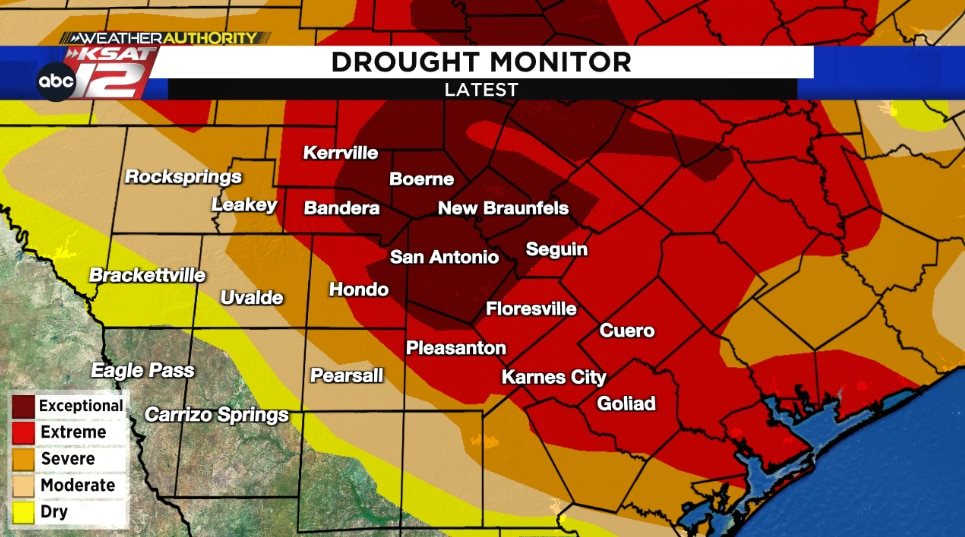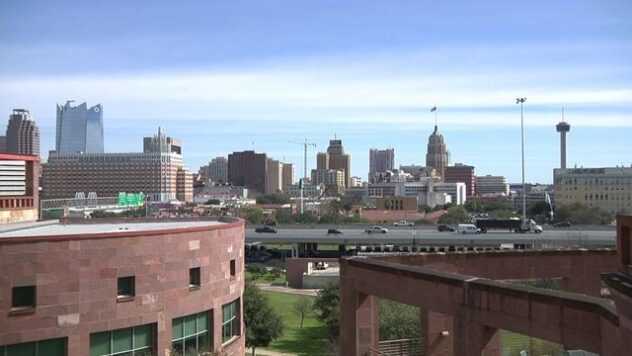How the drought in South Central Texas could impact fall foliage this season 🍂

The changing seasons bring changing colors to trees and foliage in South Central Texas, but two years of prolonged drought could impact the extent of that fall foliage this year in particular.
Key points
- Two years of prolonged drought have caused accumulating stress on local/native trees
- Wilted leaves have already been found on some trees, while others have dropped leaves early in an effort to conserve energy and resources
- This stress is expected to limit this year’s fall foliage from reaching its maximum potential since leaves are dull and some trees have shed a larger amount of leaves altogether
- 2022′s fall foliage surprised foresters since drought was already in place, but rain found in the late summer and November helped produce more color than anticipated
- Rain in the fall plus an early onset of cooler, fall temperatures can help start the color-changing process
When do we see peak fall foliage?
Peak fall foliage in South Central Texas typically takes shape in mid-to-late November, close to Thanksgiving.
Where are the best places to find fall foliage locally?
According to Erin Davis, Forester with the Texas A&M Forest Service, a highly sought-after destination for fall foliage is the Lost Maples area.
“Lost Maples is the highlight… it’s the best place to view fall foliage if the conditions are right because they have the bigtooth maples, which is our native maple and they can turn vibrant orange and red,” said Davis.
Along with the bigtooth maples, bald cypress trees also put off a beautiful russet red color in the fall. These trees can be found in Garner State Park and right here in San Antonio.
“Even the River Walk is lined with those big bald cypress trees, so you can get nice fall color there,” said Davis.
What causes leaves to change color?
Leaves contain chlorophyll, which is a pigment that keeps them green in color. Chlorophyll also helps plants make their own food through the process of photosynthesis.
When trees prepare for the winter season, they start to extract this food from the chlorophyll cells, thus allowing it to break down. As the green pigment breaks down, it reveals other pigments that are otherwise masked. These other pigments (known as carotenoids, anthocyanins, and tannins), are what produce the yellow, orange, and red hues found in the fall.
How could the drought impact this year’s fall color?
Two years of prolonged drought have caused stress to accumulate on local trees and vegetation. Davis has seen this first-hand on local trees that have wilted leaves, or ones that have already dropped their leaves to conserve energy and resources.
“We’ve seen wilted leaves and leaves dropping early… that’s just the tree trying to conserve what energy it has and not expend it throughout the leaves because it’s the leaves that transpire. So as it’s hot and dry, all that water is just getting lost and the tree can’t keep up,” said Davis.
A healthy tree is more likely to produce more vibrant colors. Since most local trees are stressed due to drought, Davis expects some dull leaves and more premature dropping due to the lack of water needed to maintain those leaves through the fall season.
“Drought-stressed trees, they might not even get fall color at all and they might just start turning brown, which we’re already starting to see,” said Davis.
Does this mean we won’t see any fall color at all?
While a lot of our trees have shed their leaves to conserve resources, additional rain leading up to mid/late November and the onset of cool temperatures could help this year’s fall color for trees that still have their leaves.
Foresters at the Texas A&M Forest Service were actually surprised at last year’s fall color considering there was drought in place. Rain found in the late summer and November contributed to more fall foliage than anticipated.
It’s something we’ll be monitoring for you over the next several weeks!
Current drought in South Central Texas
The latest drought monitor that was released Thursday (10/19) unfortunately shows no significant changes.
Exceptional drought still encompasses Bexar County and points north, while extreme drought is still in place across the Coastal Plains. Conditions gradually get better the farther south and west that you go, but we still have a lot of work to do!
- Read more from the meteorologists on the Whatever the Weather page
- Download KSAT’s weather app for customized, accurate forecasts in San Antonio, South Texas or wherever you are
- Find the latest forecasts, radar and alerts on the KSAT Weather Authority page
















